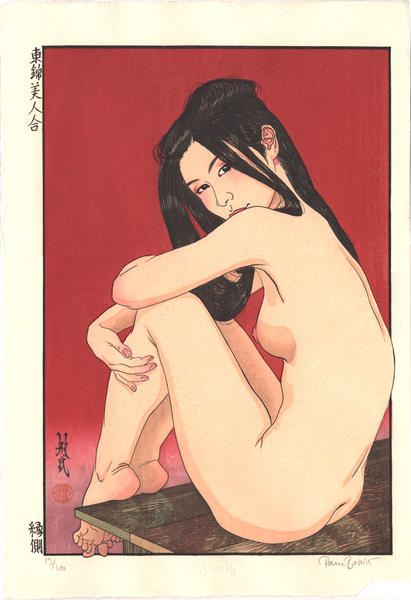| | |
| Artist: | Binnie Paul (1967- ) |
| Title: | Engawa- Veranda- 2nd edition |
| Series: | |
| Date of first edition?: | 2009 |
| Publisher (first edition)?: | Self |
| Publisher (this edition)?: | Self |
| Medium (first edition): | Woodblock |
| Medium (this edition): | Woodblock |
| Format (first edition): | Large Oban
|
| Format (this edition): | Large Oban |
| DB artwork code: | 42023 |
| Notes (first edition)?: |
|
| Notes (this edition)?: |
| The following information was taken from the original web listing of this artwork. Note that there may be some inaccuracies:
Tuesday, 30 June 2009
Engawa - Veranda, fifth design of the series of Japanese beauties, Azuma nishiki bijin awase - A collection of Eastern brocade beauties
Paper size: 31 x 45 cm. Self-printed in an edition of 100 in June 2009.
A new state of one of Paul Binnie's most popular designs, printed in 1994 in an edition of 30. That state, long sold-out now, was characterized (a.o.) by a burgundy background; the present background is "raspberry-pink", to quote Paul Binnie.
Euro 560 |
|
| Artist Bio: |
Paul Binnie was born at Airthrey Castle, Scotland in 1967 and lived in Alloa, Central Scotland until 1985. He then attended Edinburgh University and Edinburgh College of Art, taking his MA (Fine Art) in 1990. From then until the spring of 1993 he lived in Paris where he worked mostly in oils and watercolours, painting figure subjects and occasional landscapes. He began to collect Japanese Woodblock Prints in the late 1980s on a summer trip to Paris, and his extended stay in France allowed him to expand his collection and his knowledge of the subject. It was this interest in Japanese Prints along with a desire to understand the methods of their production that prompted him to move in March 1993 to Tokyo. He there sought training in the techniques of block print-making. Unable to enter the Yoshida studio, his first choice for training, due to the illness of Yoshida Toshi, he was advised to contact Seki Kenji. Kenji had been the head printer at Doi-Hangaten and Binnie worked with him for several years developing his own block printing style.
|
|


